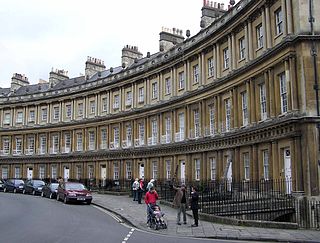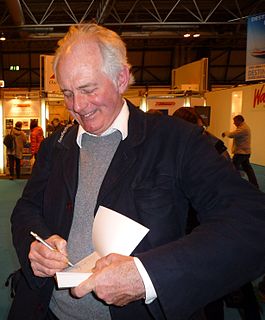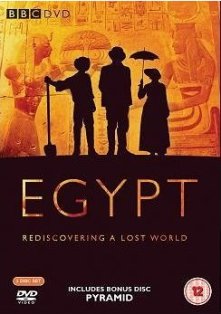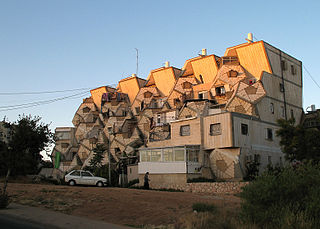
The Circus is a historic ring of large townhouses in the city of Bath, Somerset, England, forming a circle with three entrances. Designed by architect John Wood, the Elder, it was built between 1754 and 1768, and is regarded as a pre-eminent example of Georgian architecture. The name comes from the Latin circus, meaning a ring, oval or circle. It has been designated as a Grade I listed building.

Daniel Gordon Raffan Cruickshank is a British art historian and BBC television presenter, with a special interest in the history of architecture.

The Minaret of Jam is a UNESCO World Heritage Site in western Afghanistan. It is located in a remote and nearly inaccessible region of the Shahrak District, Ghor Province, next to the Hari River. The 65-metre (213 ft) or 62-metre (203 ft) high minaret was built around 1190 entirely of baked bricks and is famous for its intricate brick, stucco and glazed tile decoration, which consists of alternating bands of kufic and naskhi calligraphy, geometric patterns, and verses from the Qur'an. Since 2002, the minaret has remained on the list of World Heritage in Danger, under serious threat of erosion, and has not been actively preserved. In 2014, the BBC reported that the tower was in imminent danger of collapse.

Around the World in 80 Treasures is a 10-episode art and travel documentary series by the BBC, presented by Dan Cruickshank, and originally aired in February, March, and April 2005. The title is a reference to Around the World in Eighty Days, the classic adventure novel by Jules Verne.
The year 1723 in architecture involved some significant events.

Egypt is a BBC television docudrama serial portraying events in the history of Egyptology from the 18th through early 20th centuries. It originally aired on Sunday nights at 9 pm on BBC1 in 2005. The first two episodes explored the work of Howard Carter and his archaeological quest in Egypt in the early part of the twentieth century. The next two episodes focused on the eccentric explorer "The Great Belzoni" played here by Matthew Kelly. The final two episodes dramatise the discovery and deciphering of the Rosetta Stone by Jean-François Champollion.

Villa Barbaro, also known as the Villa di Maser, is a large villa at Maser in the Veneto region of northern Italy. It was designed and built by the Italian Renaissance architect Andrea Palladio, with frescos by Paolo Veronese and sculptures by Alessandro Vittoria, for Daniele Barbaro, Patriarch of Aquileia and ambassador to Queen Elizabeth I of England and his brother Marcantonio, an ambassador to King Charles IX of France. The villa was added to the list of World Heritage Sites by UNESCO in 1996.

Highpoint I was the first of two apartment blocks erected in the 1930s on one of the highest points in London, England, in Highgate. The architectural design was by the Georgian-British architect Berthold Lubetkin, the structural design by the Anglo-Danish engineer Ove Arup and the construction by Kier.
Invasion is a BBC documentary series in which Dan Cruickshank examines attempts and plans to invade Britain and Ireland over the years by exploring coastal fortresses and defensive structures around the coast of the country to discover their military heritage. It was first broadcast on BBC Two in October 2001.

What the Industrial Revolution Did for Us is a BBC documentary series produced in conjunction with the Open University that examines the impact of the Industrial Revolution on modern society. It was originally broadcast on BBC Two from 7 October to 11 November 2003.
The Lost World of Friese-Greene is a BBC documentary series produced in conjunction with the British Film Institute. Three one-hour episodes were broadcast on BBC Two in spring 2006.
Britain's Best Buildings was a BBC documentary series in which the TV presenter and architectural historian Dan Cruickshank discussed his selection of the finest examples of British architecture. It was first broadcast on BBC Two from 2 to 23 November 2002, and returned on BBC Four from 5 May to 2 June 2004.
Dan Cruickshank's Marvels of the Modern Age is a BBC documentary series in which Dan Cruickshank traces the roots of Modernism and focuses on the movement's leading lights, such as Le Corbusier and Frank Lloyd Wright, and the century's most seismic political events including the rise of Nazi Germany.
Towering Ambitions: Dan Cruickshank at Ground Zero is a 2003 BBC documentary film in which art historian and television presenter Dan Cruickshank tells the story of the architectural competition to rebuild Ground Zero following the 9/11 attacks, which The New Yorker architecture critic Paul Goldberger describes as "the architectural commission of a lifetime."

Dr. Finlay's Casebook is a television drama series that was produced and broadcast by the BBC from 1962 until 1971. Based on A. J. Cronin's 1935 novella Country Doctor, the storylines centred on a general medical practice in the fictional Scottish town of Tannochbrae during the late 1920s. Cronin was the primary writer for the show between 1962 and 1964.

Ramot Polin is part of the larger neighborhood of Ramot, an Israeli settlement in northwest East Jerusalem. It was constructed by the Kollel Polen (Poland) in stages beginning in 1972, under the auspices of the Office for Building and Habitation, and is populated, as intended, mostly by Haredi Jewish families, including Breslov. The neighborhood contains 720 housing units of varying sizes.

Blenheim Palace has frequently been the setting for books, TV programs and films and other events. These include:

Daibutsuyō is a Japanese religious architectural style which emerged in the late 12th or early 13th century. Together with Wayō and Zenshūyō, it is one of the three most significant styles developed by Japanese Buddhism on the basis of Chinese models.

Setchūyō is an architectural style born in Japan during the Muromachi period from the fusion of elements from three different antecedent styles: wayō, daibutsuyō, and zenshūyō. It is exemplified by the main hall at Kakurin-ji. The combination of wayō and daibutsuyō in particular became so frequent that sometimes it is classed separately by scholars under the name Shin-wayō.
The Country House Revealed is a six-part BBC series first aired on BBC Two in May 2011, in which British architectural historian Dan Cruickshank visits six houses never before open to public view, and examines the lives of the families who lived there. The series was accompanied by a full-length illustrated companion book published by the BBC.















































